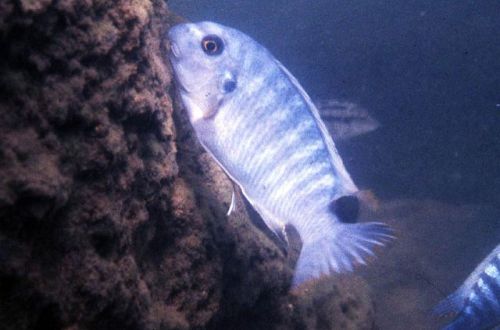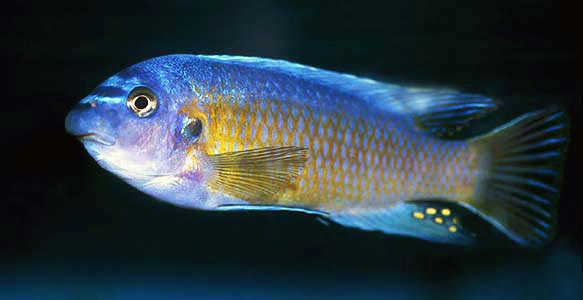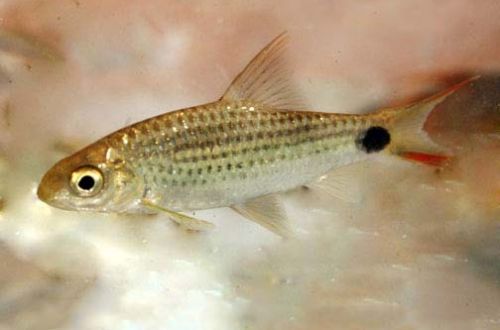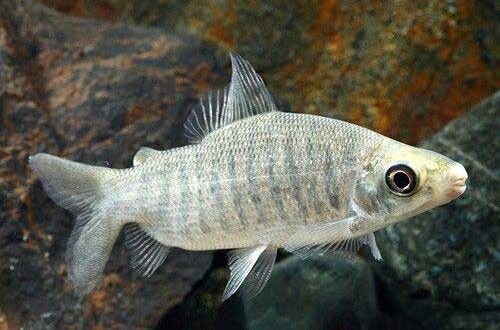
Cichlid-tapir
Labeotropheus Fuelleborna or Tapir Cichlid, also known as the Blue Mbuna, scientific name Labeotropheus fuelleborni, belongs to the Cichlidae family. Endemic to Lake Malawi in East Africa. It belongs to the group of Mbuna cichlids, which live along the coastline among heaps of rocks. It is often found in shallow water and in places with high water turbulence. Aggressive to other fish, which makes it difficult to find suitable neighbors and makes it impossible to keep them in a common aquarium, otherwise they are completely unpretentious and easy to breed.

Contents
Description
Adults reach a length of about 17 cm. The color is predominantly blue with slightly pronounced vertical stripes, sometimes with an orange tint on the sides of the body. Males are more colorful and have yellow dots on the anal fin.
The tapir cichlid has a unique overhanging mouth structure, similar to the nose of the Tapir, which gave one of the colloquial names to this species. Thanks to him, the fish can scrape algae from the surface of rocks and stones, as well as securely hold on to them, resisting the current.

Brief information:
- The volume of the aquarium – from 200 liters.
- Temperature – 24-28°C
- Value pH — 7.6–8.8
- Water hardness – medium to high hardness (10-25 dGH)
- Substrate type – sandy
- Lighting – moderate
- Brackish water – no
- Water movement is weak
- The size of the fish is about 17 cm.
- Nutrition – any based on plant components
- Temperament – aggressive
- Keeping in a harem with one male and several females
Food
In nature, the basis of the diet is algae and invertebrates and small crustaceans that fall into them. In a home aquarium, it is desirable to serve specialized food for Malawian cichlids, which contain all the necessary plant components and other additives.
Maintenance and care, arrangement of the aquarium
To successfully keep a small group of adult fish, you will need a tank of 160 liters or more. The design usually uses a sandy substrate and piles of stones, rock fragments, from which shelters are formed in the form of caves and crevices. The presence of living plants is not necessary, as they can be eaten by fish.
Water conditions have high pH and dGH values. The placement of a productive filtration system, along with a weekly replacement of part of the water with fresh water (10–15% of the volume), will help maintain hydrochemical conditions at the proper level. It is advisable to purchase filters with filter materials that increase the hardness of the water in order to avoid strong fluctuations in dGH. In addition, provide additional aeration, Fuelleborn’s Labeotropheus is sensitive to low levels of dissolved oxygen in the water.
Behavior and Compatibility
An aggressive and territorial species, it does not combine well with its relatives and representatives of other families. It is recommended to keep in the species aquarium in the ratio of one male and several females. Several males can only be housed in a sufficiently large tank, where each will have at least 150-160 liters and plenty of reliable shelters.
Breeding / breeding
The appearance of offspring of Tapir Cichlid in favorable conditions is very likely. With the onset of the mating season, the male chooses a certain area at the bottom of the aquarium – the future spawning place, usually a cave or grotto. Then he proceeds to active courtship, which sometimes looks very aggressive. At this time, its color becomes brighter, which is a clear sign of the onset of the breeding season.
When the female is ready, she accepts courtship and lays several dozen eggs, which she immediately takes into her mouth. At this moment, the male releases the seed and the eggs are fertilized already in the mouth. He no longer participates in the protection and care of offspring.
The entire incubation period and the first weeks of life, the fry spend in the mouth of the female. At this time, she does not eat anything and can noticeably lose weight. If before spawning the food supply was not regular or the diet was poor, then the female is likely to release the fry earlier, in the worst case, she will eat them.
During spawning, it is advisable to transplant the neighbors in the aquarium into another tank (if any) in order to avoid possible attacks from the male, or vice versa, place cichlids there, and return them back at the end of the mating season.
For the safety of fry in the future, they are kept in a separate aquarium with identical water conditions.
Fish diseases
The main cause of most diseases is unsuitable living conditions and poor-quality food. If the first symptoms are detected, you should check the water parameters and the presence of high concentrations of hazardous substances (ammonia, nitrites, nitrates, etc.), if necessary, bring the indicators back to normal and only then proceed with treatment. Read more about symptoms and treatments in the Aquarium Fish Diseases section.





